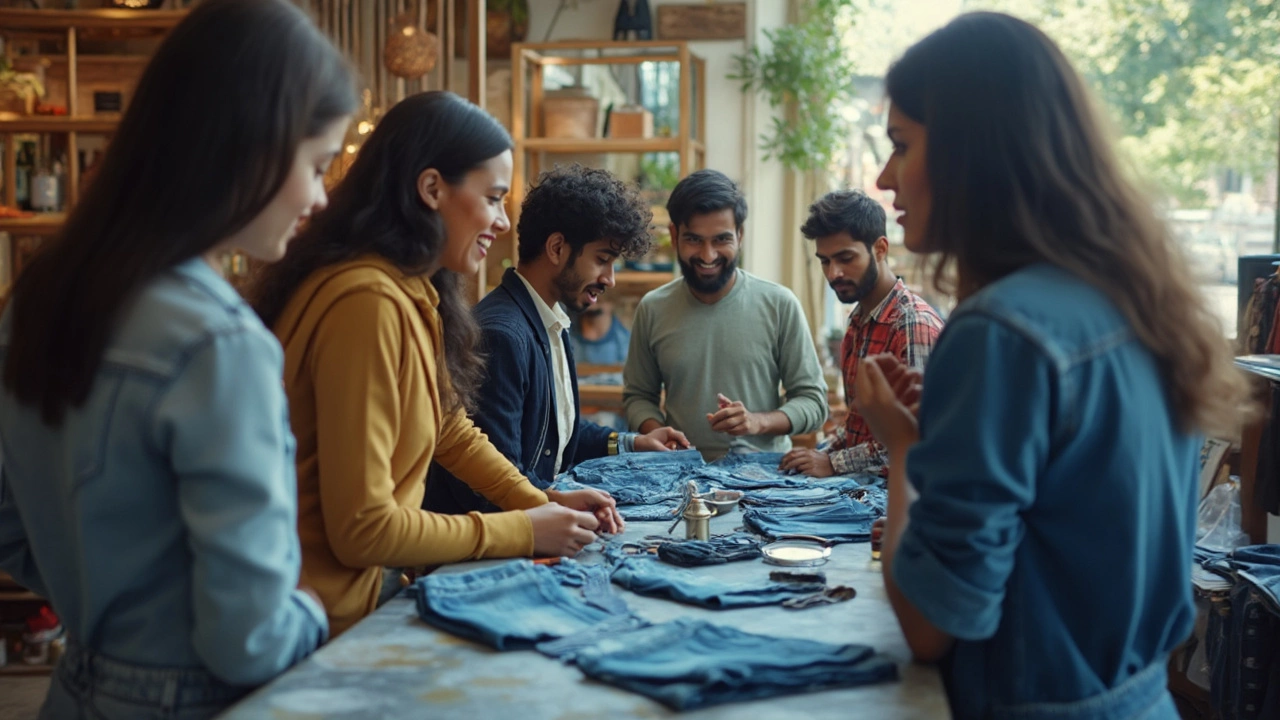Ever stood in front of a row of jeans and wondered if you’re just paying for a logo? It’s not just you—jean prices are all over the place, and brands love to hype up their high-end pairs. But are those extra dollars actually buying you jeans that last longer or feel better?
Most big-name brands bank on the idea that more expensive always means better quality. Truth is, that’s only sometimes the case. Sometimes you’re paying for marketing, sometimes for good fabric, sometimes just for a trendy little patch on the back pocket. Knowing what you’re getting can save your wallet (and your closet) a lot of drama.
Let’s get clear on what actually matters—like the fabric weight (measured in ounces), the stitching quality, and the hardware. These things can honestly make a pair of jeans survive way more roughhousing from kids like my son Gideon or endless washes. Sure, designer denim can look sleek, but if you want jeans you can trust, you need to look deeper than the price tag.
- What Really Sets Expensive Jeans Apart?
- How Denim Quality Affects Your Experience
- Are Pricey Features Worth the Hype?
- How to Pick Jeans That Last—No Matter the Price
What Really Sets Expensive Jeans Apart?
Here’s what a lot of people get wrong: the craziest price tag on expensive jeans doesn’t always land you miracle pants. But sometimes, you really do get premium stuff that stands up to daily grind, like chasing after a five-year-old or getting thrown in the washer over and over. So, let’s break down what drives some jeans into the high-end category.
The first thing is the fabric. Top-shelf jeans often use premium denim, which can be denser and feel thicker. Brands like Levi’s Red Tab or Japanese selvedge lines use cotton spun tighter and sturdier. This can up their durability by a lot—something you’ll notice if you’re tired of knees ripping out in cheap pairs.
- Selvedge denim: This is like the gold standard. It’s made on old-school shuttle looms, which means cleaner edges and less fraying over time.
- Dye and wash: More expensive options often use natural indigo dye and take more time in the finishing process. They might even hand wash and distress each pair, which is labor-intensive, adding to cost and sometimes to the look and feel.
- Hardware: Instead of plastic zippers or basic buttons, premium jeans have tough hardware—YKK zippers, custom metal rivets, and reinforced pockets that won’t bust out after a month.
- Stitching: The higher the stitch count, the better the jeans usually hold together. Double stitching and chain stitching mean fewer chances your seams will pop.
Expensive jeans sometimes go through better quality control. If you’ve ever grabbed a $30 pair, gone home, and realized the legs are different lengths, you know what I’m talking about. Premium brands are less likely to let stuff like that slide.
Check out this quick comparison of what you get for your money:
| Feature | Budget Jeans | Expensive Jeans |
|---|---|---|
| Denim Type | Mass-produced, lighter weave | Selvedge, heavy premium cotton |
| Stitching | Basic, sometimes uneven | Double-stitched, uniform |
| Hardware | Plastic or thin metal | Custom, heavy-duty metal |
| Dye Process | Synthetic, quick wash | Natural, hand-finished |
| Fit Precision | Imprecise, mass sizing | Carefully cut and sized |
So if you’re paying top dollar, check that these details line up. It’s not always just the name on the tag—sometimes the bones of those expensive jeans really do measure up.
How Denim Quality Affects Your Experience
It’s wild how much the quality of denim changes the way a pair of jeans feel, fit, and last. The first thing to check is the weight of the fabric—if you ever see a tag that says 12oz, 14oz, or even 16oz, that's not random. Lighter denim (under 12oz) feels softer and breaks in fast, but it can wear out quicker, especially at the knees and seat. Heavyweight denim (over 14oz) can feel stiff at first but will mold to your body and usually outlast your favorite sneakers.
Another biggie is the weave. Most classic denim is woven in a 3x1 twill, meaning it's sturdy but still has some give. Lower-quality jeans can have a loose weave that feels flimsy, gets baggy at the knees, and tears after a few months.
Don’t skip checking the stitching. Straight, tight stitches hold the fabric together even when you’re bending, squatting, or hunting for your car keys while chasing your kids around. Cheap jeans often have fewer stitches per inch and loose threads—easy signs that you shouldn’t expect them to last through regular wear.
Some brands brag about "selvedge" denim, which just means the fabric has finished, tightly woven edges. Selvedge jeans often stand up to frequent washing without unraveling. If you ever flip up the cuff and see a colored stripe running down the edge, you’re looking at selvedge. That’s a solid sign of durability.
Stats show high-quality denim, when cared for, can last three to five years of regular use. Inexpensive "fast-fashion" pairs sometimes barely make it through a year before seams blow out or the color fades beyond saving.
| Denim Type | Average Lifespan (Regular Use) | Typical Price Range |
|---|---|---|
| Premium Heavyweight Selvedge | 3-5 years | $90 - $250+ |
| Midweight Standard Denim | 2-3 years | $40 - $90 |
| Lightweight Fast-Fashion | 6-18 months | $15 - $40 |
Bottom line: better denim costs more to make, but it usually means more time between shopping trips, fewer rips, and less frustration. If comfort and longevity are big for you, denim quality is worth paying attention to.

Are Pricey Features Worth the Hype?
When it comes to expensive jeans, you’ll hear a lot about "special" features. Things like Japanese selvage denim, branded hardware, or secret stitching patterns. But here’s the real kicker—not all pricey upgrades are created equal. Some add something worthwhile, and some are just there to up the wow factor on the price tag.
Take a look at selvage denim, for example. Brands often charge more for it. It’s made on old-school shuttle looms, which means tighter weaving and fewer frayed edges. These jeans can actually last longer and feel sturdier, but the difference won’t always matter for everyone. If you’re not rough on your clothes, those details might be lost on you.
Then there’s the hardware—rivets, zips, and buttons. On more expensive jeans, these will sometimes be made from solid copper, brass, or even steel. They hold up better to wear and tear. That’s something you really notice if you use your jeans day in and day out, especially if you’re like me and have a kid who ends up giving your jeans a beating during playtime.
- Stitching: Durable, double or chain stitching helps stop your jeans from splitting at the seams. Pricy brands might use tighter stitching, but you can check this even on cheaper jeans.
- Pocket Lining: Better quality denim brands often use thicker, tougher cloth for pocket linings. Ever had keys pop through a pocket? That’s why this matters.
- Fabric Weight: More expensive jeans usually use heavier denim (think 12-16oz), which can really hold up for years. Lighter denim is more likely to rip but feels comfier in hot weather.
Some features—like designer tags, colored rivets, or artist collaborations—basically just drive the price up. Sure, they look cool. But if you care about jeans quality and durability, they won’t do you any favors.
Here’s a quick look at a couple of common upgrades and what they really do for you:
| Feature | Worth the Cost? | Why It Matters |
|---|---|---|
| Selvage Denim | Usually | Durable, neat finish—stands up to wear |
| Heavyweight Fabric (14oz+) | If you want rugged jeans | Longer lasting, less ripping |
| Designer Logos | Not really | All style, zero impact on function |
| Copper Rivets | Yes | Add real strength to stress points |
Long story short, some expensive features actually help your denim hold up and fit better. But don’t let a shiny tag or limited-edition color fool you—it’s the basics that count if you want jeans that last. Feel the fabric, tug at the seams, and check the hardware. That’ll tell you more than any brand ever could.
How to Pick Jeans That Last—No Matter the Price
You don’t need to drop serious cash to score jeans quality that actually holds up. Forget the price tag for a second, and focus on what you can see and feel. Here’s what you really want to pay attention to:
- Fabric weight: Good denim usually sits between 12 and 16 ounces per square yard. Thicker denim isn’t as soft at first, but it stands up way better to everyday wear and those accidental playground slides or bike spills that kids like Gideon seem to love.
- Stitching: Flip those jeans inside out. Look for tight, clean double stitching on the seams, especially around the pockets and crotch. Loose or skipped threads? Skip those jeans—they’re headed for the donation bin faster than you’d like.
- Hardware: Real quality denim uses solid metal buttons and rivets (not plastic or flimsy metal). YKK zippers are a safe bet—most brands use them, and they’re less likely to break at the worst moment.
- Fit: If jeans don’t fit well, you’ll never wear them. Sit, squat, or chase your kids for a minute in the fitting room. The right pair shouldn’t dig in or sag out after a few hours.
- Country of origin: Japan, Italy, and the USA still hold strong reputations for making tough, high-quality denim. Don’t rule out jeans made elsewhere, but check reviews or ask questions on the brand’s website. Some smaller brands really surprise you here.
Here’s a quick look at how common jeans stack up with these features:
| Jeans Brand | Fabric Weight | Stitching | Main Hardware | Price Range |
|---|---|---|---|---|
| Levi's 501 | 12-14 oz | Double-stitched | Metal, YKK | $60-$90 |
| Uniqlo Selvedge | 13.5 oz | Reinforced | Metal, YKK | $50-$70 |
| APC New Standard | 14.5 oz | Double-stitched | Metal, YKK | $200+ |
| Wrangler Regular | 12-13 oz | Standard | Metal, YKK | $30-$55 |
Labels can be sneaky about "premium" or "exclusive" but those buzzwords don’t always mean you’re getting a longer-lasting pair. Feel the fabric. Check the seams. Try them on. If you find the basics are rock solid, you’ve got yourself a keeper—fancy branding or not.
One last tip: Don’t skip care instructions. Washing jeans inside out on cold and hanging them to dry really does make a difference. I’ve kept a pair for nearly a decade by doing just that.
